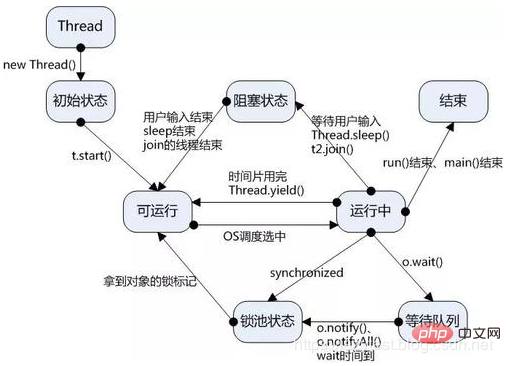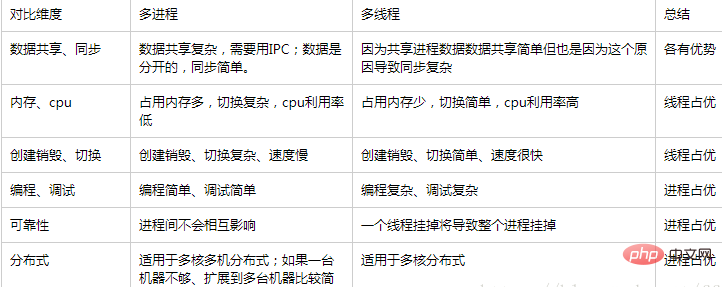Collection of classic Java interview questions (4)

1. Application scenarios of reflection mechanism
(Related tutorial recommendations: java interview questions)
Reverse code, such as decompilation
Framework combined with annotations such as Retrofit
Simple reflection mechanism Application frameworks such as EventBus 2.x
Dynamically generated class frameworks such as Gson
2. What is multi-threading?
Multi-threading refers to the technology that realizes the concurrent execution of multiple threads from software or hardware. In a program, these independently running program fragments are called "threads", and the concept of programming using them is called "multi-threading".
Computers with multi-threading capabilities can execute more than one thread at the same time due to hardware support, thus improving overall processing performance.

#The main thread is the first thread generated in the creation process, which is the thread corresponding to the main function.
(Recommended learning: java introductory program)
3. Tell me about the benefits of multi-threading?
1. Advantages of multi-threading
The cost of creating a new thread is much smaller than creating a new process
Compared with switching between processes, switching between threads requires the operating system to do very little work
Threads occupy much fewer resources than processes
Can make full use of the parallel number of multi-processors
After waiting for the slow IO operation to end, the program can perform other computing tasks
Computing (CPU)-intensive applications, in order to run on multi-processor systems, the calculation is broken down into multiple threads to implement
IO-intensive applications , in order to improve performance, IO operations are overlapped, and threads can wait for different IO operations.
2. Disadvantages of multi-threading
Performance loss (a computing-intensive thread is rarely blocked by external events and cannot communicate with other Threads share the same processor. When the number of computationally intensive threads is more than the available processors, there may be a large performance loss. The performance loss here refers to the additional synchronization and scheduling overhead. Two available Resources remain unchanged.)
The robustness is reduced (there is a lack of protection between threads. In a multi-threaded program, due to the slight difference in time allocation or the sharing of some incorrect The possible impact of adverse effects on variables that should be shared is very large.)
Lack of access control (because the process is the basic granularity of access control, calling certain OS in a thread Functions will affect the entire process.)
Increased programming difficulty (writing and debugging a multi-threaded program is much more difficult than a single-threaded program.)
4. What is the difference between threads and processes?
1. Scheduling
The process is a basic unit for the operating system to allocate resources. Threads are the basic unit of CPU scheduling.
2. Concurrency
After the introduction of threads, not only processes can be executed concurrently, but multiple threads in a process can also be executed concurrently, even allowing one All processes in the process execute concurrently.
Similarly, threads in different processes can also be executed concurrently. This enables the OS to have better concurrency, improving resource utilization and system throughput.
3. Owning resources
A process can own resources and is the basic unit of system resource ownership. The thread itself does not own system resources, only some resources that can ensure independent operation. This resource is private to each thread.
For example, thread ID, a set of registers, stack, errno, signal mask word (there is only one pending signal in a process, but any thread can handle this signal), scheduling priority.
4. Independence
The independence of threads in the same process is much lower than that in different processes.
5. System overhead
The cost of thread switching is lower than the cost of process switching.
6.Support multi-processor system
For traditional processes , that is, a single-threaded process, no matter how many processors there are, the process can only run on the same processor, but for a multi-threaded process, multiple threads in a process can be assigned to multiple processors, so that Its concurrent execution speeds up the completion of the process.
(Video tutorial recommendation: java video tutorial)
5. Application scenarios of processes and threads

Need to frequently create and destroy priority threads.
Prioritize threads that require large amounts of calculations.
Threads are used for strong correlations, and processes are used for weak correlations.
It may be extended to use processes for multi-machine distribution and threads for multi-core distribution.
The above is the detailed content of Collection of classic Java interview questions (4). For more information, please follow other related articles on the PHP Chinese website!

Hot AI Tools

Undresser.AI Undress
AI-powered app for creating realistic nude photos

AI Clothes Remover
Online AI tool for removing clothes from photos.

Undress AI Tool
Undress images for free

Clothoff.io
AI clothes remover

Video Face Swap
Swap faces in any video effortlessly with our completely free AI face swap tool!

Hot Article

Hot Tools

Notepad++7.3.1
Easy-to-use and free code editor

SublimeText3 Chinese version
Chinese version, very easy to use

Zend Studio 13.0.1
Powerful PHP integrated development environment

Dreamweaver CS6
Visual web development tools

SublimeText3 Mac version
God-level code editing software (SublimeText3)

Hot Topics
 1671
1671
 14
14
 1428
1428
 52
52
 1329
1329
 25
25
 1276
1276
 29
29
 1256
1256
 24
24
 PHP vs. Python: Understanding the Differences
Apr 11, 2025 am 12:15 AM
PHP vs. Python: Understanding the Differences
Apr 11, 2025 am 12:15 AM
PHP and Python each have their own advantages, and the choice should be based on project requirements. 1.PHP is suitable for web development, with simple syntax and high execution efficiency. 2. Python is suitable for data science and machine learning, with concise syntax and rich libraries.
 PHP: A Key Language for Web Development
Apr 13, 2025 am 12:08 AM
PHP: A Key Language for Web Development
Apr 13, 2025 am 12:08 AM
PHP is a scripting language widely used on the server side, especially suitable for web development. 1.PHP can embed HTML, process HTTP requests and responses, and supports a variety of databases. 2.PHP is used to generate dynamic web content, process form data, access databases, etc., with strong community support and open source resources. 3. PHP is an interpreted language, and the execution process includes lexical analysis, grammatical analysis, compilation and execution. 4.PHP can be combined with MySQL for advanced applications such as user registration systems. 5. When debugging PHP, you can use functions such as error_reporting() and var_dump(). 6. Optimize PHP code to use caching mechanisms, optimize database queries and use built-in functions. 7
 Break or return from Java 8 stream forEach?
Feb 07, 2025 pm 12:09 PM
Break or return from Java 8 stream forEach?
Feb 07, 2025 pm 12:09 PM
Java 8 introduces the Stream API, providing a powerful and expressive way to process data collections. However, a common question when using Stream is: How to break or return from a forEach operation? Traditional loops allow for early interruption or return, but Stream's forEach method does not directly support this method. This article will explain the reasons and explore alternative methods for implementing premature termination in Stream processing systems. Further reading: Java Stream API improvements Understand Stream forEach The forEach method is a terminal operation that performs one operation on each element in the Stream. Its design intention is
 PHP vs. Other Languages: A Comparison
Apr 13, 2025 am 12:19 AM
PHP vs. Other Languages: A Comparison
Apr 13, 2025 am 12:19 AM
PHP is suitable for web development, especially in rapid development and processing dynamic content, but is not good at data science and enterprise-level applications. Compared with Python, PHP has more advantages in web development, but is not as good as Python in the field of data science; compared with Java, PHP performs worse in enterprise-level applications, but is more flexible in web development; compared with JavaScript, PHP is more concise in back-end development, but is not as good as JavaScript in front-end development.
 PHP vs. Python: Core Features and Functionality
Apr 13, 2025 am 12:16 AM
PHP vs. Python: Core Features and Functionality
Apr 13, 2025 am 12:16 AM
PHP and Python each have their own advantages and are suitable for different scenarios. 1.PHP is suitable for web development and provides built-in web servers and rich function libraries. 2. Python is suitable for data science and machine learning, with concise syntax and a powerful standard library. When choosing, it should be decided based on project requirements.
 PHP's Impact: Web Development and Beyond
Apr 18, 2025 am 12:10 AM
PHP's Impact: Web Development and Beyond
Apr 18, 2025 am 12:10 AM
PHPhassignificantlyimpactedwebdevelopmentandextendsbeyondit.1)ItpowersmajorplatformslikeWordPressandexcelsindatabaseinteractions.2)PHP'sadaptabilityallowsittoscaleforlargeapplicationsusingframeworkslikeLaravel.3)Beyondweb,PHPisusedincommand-linescrip
 PHP: The Foundation of Many Websites
Apr 13, 2025 am 12:07 AM
PHP: The Foundation of Many Websites
Apr 13, 2025 am 12:07 AM
The reasons why PHP is the preferred technology stack for many websites include its ease of use, strong community support, and widespread use. 1) Easy to learn and use, suitable for beginners. 2) Have a huge developer community and rich resources. 3) Widely used in WordPress, Drupal and other platforms. 4) Integrate tightly with web servers to simplify development deployment.
 PHP vs. Python: Use Cases and Applications
Apr 17, 2025 am 12:23 AM
PHP vs. Python: Use Cases and Applications
Apr 17, 2025 am 12:23 AM
PHP is suitable for web development and content management systems, and Python is suitable for data science, machine learning and automation scripts. 1.PHP performs well in building fast and scalable websites and applications and is commonly used in CMS such as WordPress. 2. Python has performed outstandingly in the fields of data science and machine learning, with rich libraries such as NumPy and TensorFlow.




